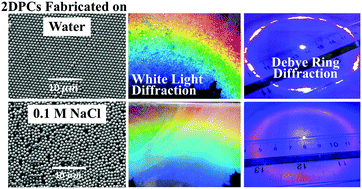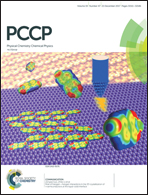Debye ring diffraction elucidation of 2D photonic crystal self-assembly and ordering at the air–water interface†
Abstract
We fabricate 2D photonic crystals (2DPC) by spreading a dispersion of charged colloidal particles (diameters = 409, 570, and 915 nm) onto the surface of electrolyte solutions using a needle tip flow method. When the interparticle electrostatic interaction potential is large, particles self-assemble into highly ordered hexagonal close packed (hcp) monolayers. Ordered 2DPC efficiently forward diffract monochromatic light to produce a Debye ring on a screen parallel to the 2DPC. The diameter of the Debye ring is inversely proportional to the 2DPC particle spacing, while the Debye ring brightness and thickness depends on the 2DPC ordering. The Debye ring thickness increases as the 2DPC order decreases. The Debye ring ordering measurements of 2DPC attached to glass slides track measurements of the 2D pair correlation function order parameter calculated from SEM micrographs. The Debye ring method was used to investigate the 2DPC particle spacing, and ordering at the air–solution interface of NaCl solutions, and for 2DPC arrays attached to glass slides. Surprisingly, the 2DPC ordering does not monotonically decrease as the salt concentration increases. This is because of chloride ion adsorption onto the anionic particle surfaces. This adsorption increases the particle surface charge and compensates for the decreased Debye length of the electric double layer when the NaCl concentration is below a critical value.



 Please wait while we load your content...
Please wait while we load your content...